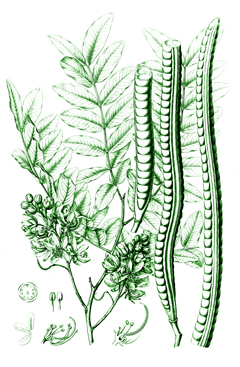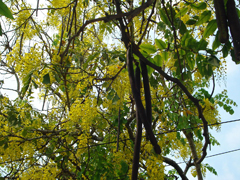 |
|
https://edibleplants.org/ |
 |
| wikimedia.org |
Translate this page:
Summary
Found in South America, Marimari or Cassia leiandra, is a small tree of 6-14 m height with usually twisted trunk of around 30 cm in diameter and a wide, spreading crown. Though popular for the acidic-sweet, edible fruit, marimari is also used as an ornamental tree due to its yellow flowers located at the end of branches. The tree is grown from seeds.
Found In: Amazon, Brazil, South America. Other Names: Seruia, Inga-mari, Marimari-da-varzea, Fava-marimari.
Physical Characteristics

 Cassia leiandra is a deciduous Tree growing to 10 m (32ft) by 10 m (32ft) at a fast rate.
Cassia leiandra is a deciduous Tree growing to 10 m (32ft) by 10 m (32ft) at a fast rate.
See above for USDA hardiness. It is hardy to UK zone 10. The flowers are pollinated by Insects.
It can fix Nitrogen.
It is noted for attracting wildlife.
Suitable for: medium (loamy) and heavy (clay) soils and can grow in heavy clay soil. Suitable pH: mildly acid, neutral and basic (mildly alkaline) soils and can grow in very acid soils.
It cannot grow in the shade. It prefers moist or wet soil.
UK Hardiness Map
US Hardiness Map
Synonyms
Cassia moschata Benth.
Plant Habitats
Edible Uses
Edible Parts: Fruit
Edible Uses:
Edible portion: Fruit. Fruit - raw[ 416 ]. The acidic-sweet, juicy pulp surrounding the seeds is eaten[ 317 , 416 , 420 ]. The fruit is harvested whilst the seeds are still green[ 416 ]. The fruit is a legume 40 - 70cm long and about 3cm wide[ 416 ].
References More on Edible Uses
Medicinal Uses
Plants For A Future can not take any responsibility for any adverse effects from the use of plants. Always seek advice from a professional before using a plant medicinally.
None known
References More on Medicinal Uses
The Bookshop: Edible Plant Books
Our Latest books on Perennial Plants For Food Forests and Permaculture Gardens in paperback or digital formats.

Edible Tropical Plants
Food Forest Plants for Hotter Conditions: 250+ Plants For Tropical Food Forests & Permaculture Gardens.
More

Edible Temperate Plants
Plants for Your Food Forest: 500 Plants for Temperate Food Forests & Permaculture Gardens.
More

More Books
PFAF have eight books available in paperback and digital formats. Browse the shop for more information.
Shop Now
Other Uses
Pioneer Wood
Other uses rating: Low (2/5). Agroforestry Uses: A natural pioneer species in its native range - it could be used in local reforestation projects[ K ]. Other Uses The wood is thick-textured, moderately heavy, soft, of low durability and easy to work[ 420 ]. It is only used locally, for applications such as internal work in the construction of rustic houses, tool handles, cheap toys, boxes etc[ 420 ].
Special Uses
Food Forest
References More on Other Uses
Cultivation details
A tropical plant. Prefers a sunny position[ 420 ]. Often found in the wild on heavy, wet, clay soils[ 420 ]. Plants are tolerant of seasonal inundation of the soil[ 420 ]. A fast-growing plant[ 420 ]. Sometimes cultivated as a fruit tree.
References Carbon Farming Information and Carbon Sequestration Information
Temperature Converter
Type a value in the Celsius field to convert the value to Fahrenheit:
Fahrenheit:
The PFAF Bookshop
Plants For A Future have a number of books available in paperback and digital form. Book titles include Edible Plants, Edible Perennials, Edible Trees,Edible Shrubs, Woodland Gardening, and Temperate Food Forest Plants. Our new book is Food Forest Plants For Hotter Conditions (Tropical and Sub-Tropical).
Shop Now
Plant Propagation
Seed - best sown as soon as it is ripe. The seed has a hard seedcoat and may benefit from scarification before sowing to speed up germination. This can usually be done by pouring a small amount of nearly boiling water on the seeds (being careful not to cook them!) and then soaking them for 12 - 24 hours in warm water. By this time they should have imbibed moisture and swollen - if they have not, then carefully make a nick in the seedcoat (being careful not to damage the embryo) and soak for a further 12 hours before sowing. Sow in a sunny position in a nursery seedbed. Germination should take place within 2 - 4 weeks. Young seedlings grow quickly[ 420 ].
Other Names
If available other names are mentioned here
Marimari or Cassia leiandra.Other Names: Seruia, Inga-mari, Marimari-da-varzea, Fava-marimari.
Native Range
SOUTHERN AMERICA: Brazil, Amazonas, Pará (west),
Weed Potential
Right plant wrong place. We are currently updating this section.
Please note that a plant may be invasive in one area but may not in your area so it's worth checking.
None Known
Conservation Status
IUCN Red List of Threatened Plants Status : This taxon has not yet been assessed.

Growth: S = slow M = medium F = fast. Soil: L = light (sandy) M = medium H = heavy (clay). pH: A = acid N = neutral B = basic (alkaline). Shade: F = full shade S = semi-shade N = no shade. Moisture: D = dry M = Moist We = wet Wa = water.
Now available:
Food Forest Plants for Mediterranean Conditions
350+ Perennial Plants For Mediterranean and Drier Food Forests and Permaculture Gardens.
[Paperback and eBook]
This is the third in Plants For A Future's series of plant guides for food forests tailored to
specific climate zones. Following volumes on temperate and tropical ecosystems, this book focuses
on species suited to Mediterranean conditions—regions with hot, dry summers and cool, wet winters,
often facing the added challenge of climate change.
Read More
Expert comment
Author
Benth.
Botanical References
Links / References
For a list of references used on this page please go here
A special thanks to Ken Fern for some of the information used on this page.
Readers comment
| Add a comment |
|
If you have important information about this plant that may help other users please add a comment or link below. Only comments or links that are felt to be directly relevant to a plant will be included. If you think a comment/link or information contained on this page is inaccurate or misleading we would welcome your feedback at [email protected]. If you have questions about a plant please use the Forum on this website as we do not have the resources to answer questions ourselves.
* Please note: the comments by website users are not necessarily those held by PFAF and may give misleading or inaccurate information.
To leave a comment please Register or login here All comments need to be approved so will not appear immediately.
|
Subject : Cassia leiandra
|
|
|
|